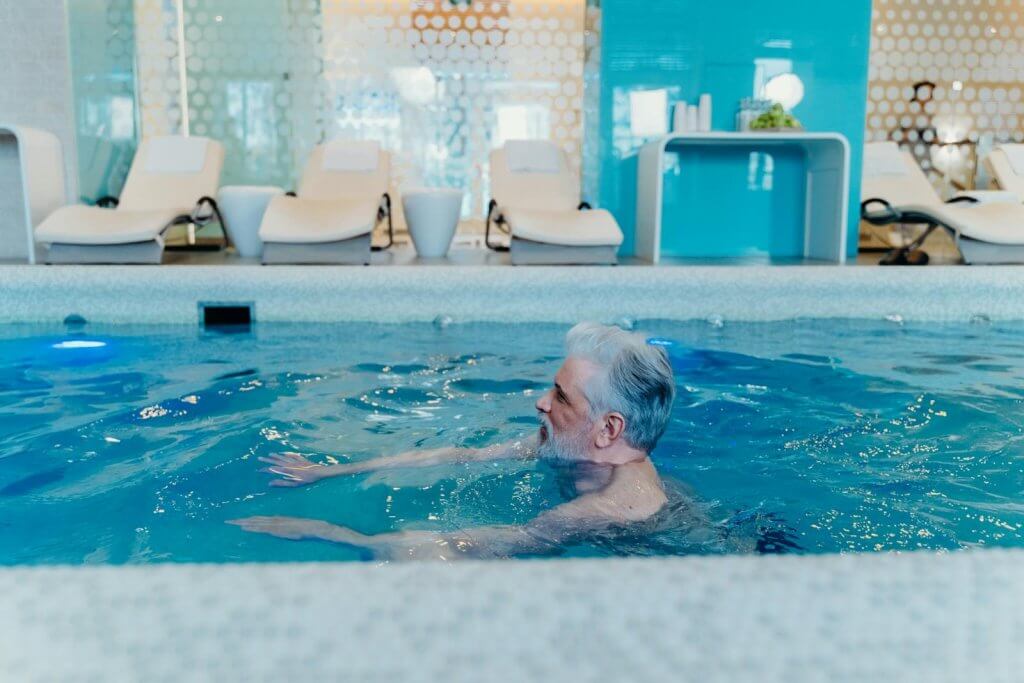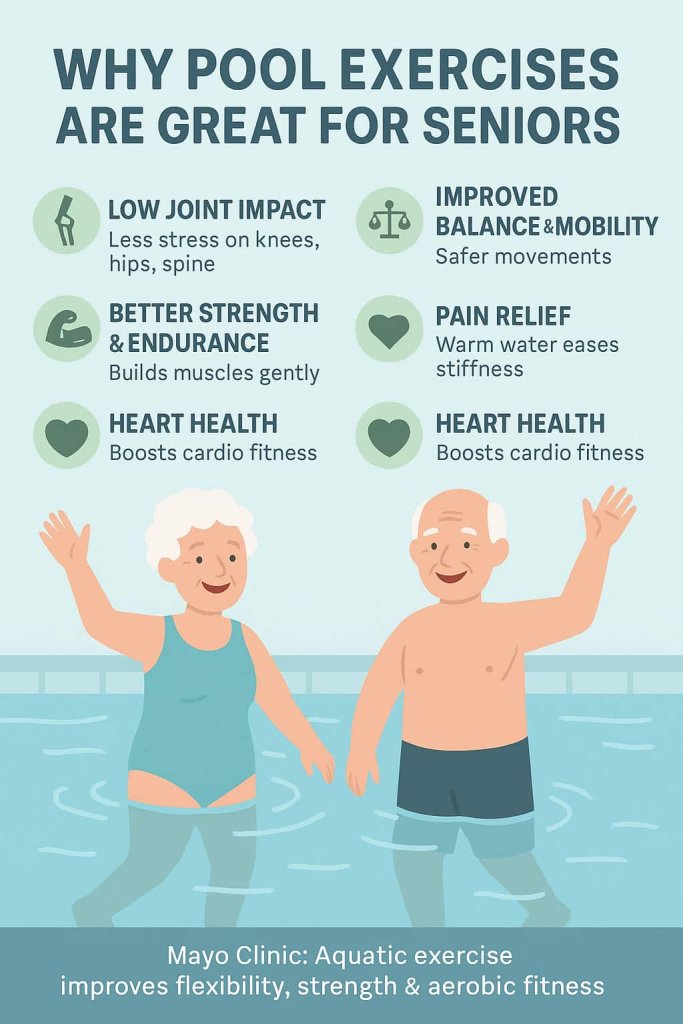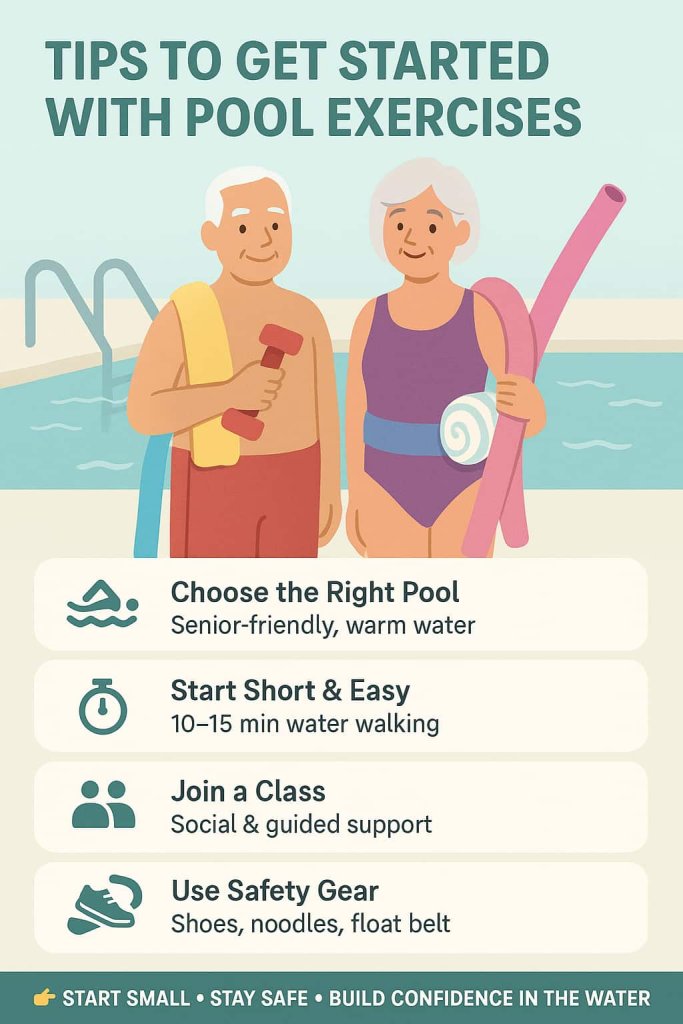Yes, seniors can safely and effectively improve strength, balance, and mobility with pool exercises. Water’s buoyancy reduces joint stress, making aquatic workouts one of the best low-impact fitness options for older adults.

Understanding pool exercises is important because they support healthy aging, help manage arthritis pain, improve cardiovascular endurance, and reduce fall risk. Seniors can enjoy activities like water walking, deep-water jogging, leg lifts, and balance drills—all in a safe, fun, and refreshing environment.
This guide explains the 15 best pool exercises for seniors, along with benefits, safety tips, and answers to common questions.
Why Pool Exercises Are Great for Seniors

- Low joint impact – Buoyancy eases pressure on knees, hips, and spine.
- Improved balance & mobility – Water supports movement, lowering fall risk.
- Better strength & endurance – Natural resistance builds muscles without heavy weights.
- Pain relief – Warm water reduces stiffness from arthritis and chronic conditions.
- Heart health – Aerobic pool workouts support cardiovascular function.
👉 According to the Mayo Clinic, aquatic exercise improves flexibility, strength, and aerobic fitness while reducing stress on the body’s joints (Mayo Clinic).
Tips to Get Started with Pool Exercises
Beginning aquatic exercise doesn’t need to be overwhelming. Keep these starter tips in mind:

- Choose the right pool – Look for senior-friendly facilities with ramps, rails, and ideally warmer water (28–32°C / 82–90°F).
- Start short and easy – Begin with 10–15 minutes of water walking, then gradually add exercises.
- Join a class – Group aqua-fitness classes for seniors provide instructor guidance and social support.
- Use safety gear – Water shoes, noodles, or a float belt improve grip, balance, and comfort.
- Schedule wisely – Mid-morning or early afternoon is best, when pools are less crowded.
15 Best Pool Exercises for Seniors
Pool exercises are one of the safest and most effective ways for seniors to stay active. The buoyancy of water reduces joint stress by up to 90%, while still providing resistance to build strength, endurance, and balance. Below are 15 pool exercises designed to improve mobility, cardiovascular health, and confidence in movement.
1. Water Walking (Forward & Backward)
How to do it:
- Enter waist- or chest-deep water.
- Walk slowly forward, swinging arms naturally.
- Then walk backward, keeping steps controlled.
Benefits: Improves cardiovascular fitness, strengthens legs, and enhances stability.
Trainer Tip: Keep steps small and avoid leaning too far forward or back. Use the pool wall for support if needed.
2. High-Knee Lifts with Extensions
How to do it:
- Stand tall in chest-deep water.
- Lift one knee toward your chest.
- Extend your leg forward, hold briefly, then lower.
- Alternate legs.
Benefits: Strengthens hips, thighs, and core, supporting daily activities like stair climbing.
Trainer Tip: Perform slowly for better control and balance.
3. Leg Kicks (Flutter, Scissor, Breaststroke Style)
How to do it:
- Hold onto the pool edge or a kickboard.
- Perform flutter kicks (small, fast), scissor kicks (alternating wide), or breaststroke kicks (outward and together).
Benefits: Builds leg endurance, hip mobility, and cardiovascular fitness.
Trainer Tip: Start with short sets (15–20 seconds) and increase duration as stamina improves.
4. Side Leg Raises
How to do it:
- Stand near a wall or rail.
- Lift one leg to the side, keeping torso upright.
- Lower slowly and repeat. Switch legs.
Benefits: Strengthens hips, outer thighs, and improves balance.
Trainer Tip: Keep movements controlled, not jerky. Use the water’s resistance instead of speed.
5. Front Arm Lifts with Water Weights
How to do it:
- Hold water dumbbells with arms at your sides.
- Raise arms forward to shoulder height, then lower.
Benefits: Builds shoulder and upper-body strength, improves posture.
Trainer Tip: Exhale as you lift and inhale as you lower to maintain rhythm.
6. Lateral Arm Raises
How to do it:
- Hold water weights at sides.
- Lift arms outward to shoulder height, then return.
Benefits: Strengthens shoulders, making everyday reaching tasks easier.
Trainer Tip: Avoid shrugging shoulders; keep neck relaxed.
7. Arm Push/Pull Resistance
How to do it:
- Stand chest-deep, arms extended forward.
- Push arms outward, then pull inward against water resistance.
- Use gloves or paddles for added resistance.
Benefits: Works chest, back, and arms without weights.
Trainer Tip: Keep core tight for stability.
8. Wall Push-Off & Glide
How to do it:
- Place feet against pool wall.
- Push off gently, glide forward, then tuck knees in.
- Repeat several times.
Benefits: Improves coordination, core strength, and balance.
Trainer Tip: Perform in a safe area away from other swimmers.
9. Pool Noodle Balance Training
How to do it:
- Hold a pool noodle under arms or use a float belt.
- Practice standing on one leg, gentle twisting, or shifting weight side to side.
Benefits: Enhances balance, stability, and confidence in water.
Trainer Tip: Start with both feet planted before progressing to single-leg stances.
10. Deep-Water Jogging
How to do it:
- Wear a floatation belt in the deep end.
- Jog in place or across pool, swinging arms naturally.
Benefits: Excellent low-impact cardio workout with zero joint stress.
Trainer Tip: Keep movements upright, not leaning forward.
11. Water Jumping Jacks
How to do it:
- Stand chest-deep in water.
- Perform traditional jumping jacks (arms + legs out and in).
- For low-impact, step side to side instead of jumping.
Benefits: Boosts endurance, coordination, and flexibility.
Trainer Tip: Land softly; the water will cushion your joints.
12. Water Cycling (Pedaling Motion)
How to do it:
- Hold onto the pool wall or use a floatation belt.
- Mimic cycling by moving legs in a circular pedaling motion.
- Option: Use an underwater stationary bike if available.
Benefits: Strengthens legs, improves circulation, and supports joint mobility.
Trainer Tip: Keep movement smooth to avoid knee strain.
13. Core Twists & Torso Rotations
How to do it:
- Stand chest-deep, feet shoulder-width apart.
- Hold arms out in front and twist torso left and right gently.
Benefits: Improves core strength, spinal mobility, and posture.
Trainer Tip: Move slowly and keep hips facing forward to target the waist.
14. Side Shuffle Walks
How to do it:
- Stand in waist- or chest-deep water.
- Step sideways across pool, crossing feet or shuffling.
- Return in opposite direction.
Benefits: Strengthens hips, improves lateral balance and coordination.
Trainer Tip: Keep knees slightly bent for better stability.
15. Water Squats (Knee Bends)
How to do it:
- Stand in chest-deep water, feet shoulder-width apart.
- Bend knees as if sitting in a chair, then return to standing.
Benefits: Strengthens glutes, thighs, and supports standing movements.
Trainer Tip: Keep back upright; don’t lean forward.
Safety Tips for Seniors in the Pool
- Warm up with 5–10 minutes of gentle water walking.
- Water temperature: 28–30°C (82–86°F) is ideal for moderate exercise.
- Use water shoes, noodles, or float belts for added stability.
- Stay hydrated even if you don’t feel sweaty.
- Stop if you feel dizzy, short of breath, or in pain.
- Always consult a doctor before starting if you have arthritis, osteoporosis, or heart conditions.
👉 The Aquatic Exercise Association (AEA) recommends warm-water therapy pools (around 30–32°C / 86–90°F) for arthritis relief (AEA Guidelines PDF).
Who Should Avoid Pool Exercises?
While pool workouts are safe for most seniors, a few should proceed with caution or avoid them altogether:
- Those with untreated open wounds or skin infections – Chlorine may irritate wounds, and open sores increase infection risk.
- Individuals with uncontrolled heart or lung conditions – Water pressure affects circulation and breathing. Always seek medical clearance.
- Seniors with severe balance issues – If you cannot enter/exit the pool safely, you should only do aquatic exercise under supervision.
- People with contagious illnesses – Such as flu, gastrointestinal infections, or severe colds.
👉 Always consult your doctor before starting, especially if you have chronic conditions or recent surgeries.
FAQs About Pool Exercises for Seniors
1. Are pool exercises good for arthritis?
Yes. Warm water reduces joint stiffness and pain, making exercise easier and safer.
2. How often should seniors do pool workouts?
Aim for 2–3 sessions per week, 20–45 minutes each.
3. Do you need equipment for pool exercises?
Not required, but water dumbbells, noodles, and float belts can add safety and resistance.
4. Can seniors with osteoporosis do water workouts?
Yes, aquatic exercises are joint-friendly and improve balance, reducing fall risk.
5. Is deep-water exercise safe for non-swimmers?
Yes, with a float belt or noodle. Always stay in supervised pools and shallow water if unsure.
6. Do pool exercises help with weight loss?
Yes. Aquatic workouts burn calories and support cardiovascular health.
7. What’s the best time of day for seniors to exercise in the pool?
Late morning or early afternoon is best, when energy is higher and pool water is comfortably warm.
Conclusion
Pool exercises are one of the best low-impact workouts for seniors. From water walking to deep-water jogging, these 15 moves improve strength, mobility, balance, and cardiovascular health—all while reducing joint stress.
👉 Start with simple water walking, then gradually add more challenging moves. Consistency is key.
